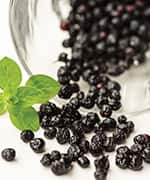Life Extension Magazine®
Dry eye syndrome affects up to 49 million Americans.1,2
Widespread use of smart phones, tablets, computers, and other digital screens contributes to the condition.3
Left untreated, dry eye syndrome can lead to permanent eye damage.4 It also can affect work productivity and contributes to automobile accidents.3,5
Over-the-counter eye drops provide short-term relief.6 Prescription medications for dry eye syndrome can be very costly and have side effects including itching, stinging, burning, and redness.7,8
Scientists have identified a berry extract that, taken orally, can boost the body's own production of natural tears.9,10
A pilot study showed that an oral extract of maqui berry provides a 72% improvement in dry eye symptoms.10
A larger clinical trial confirmed that maqui berry increases tear production and reduces eye dryness and eye fatigue, delivering long-lasting effects.11
Discomfort and Eye Damage
Dry eyes are a daily annoyance for those who experience this problem. This includes stinging, itching, light sensitivity, difficulty focusing, and more.
Studies show that dry eye irritation is associated with lower scores on standard mental health scales and a lower quality of life.12,13
Without treatment, dry eyes can eventually cause eye damage.4
Tears are essential for lubricating and protecting the cornea, the front central surface of the eye. They protect the eye from infection, wash away foreign matter, and deliver critical nutrients to its surface.14,15
People suffering from dry eye syndrome often produce either too few tears or tears that are poor quality.15,16
As a result, the cornea can become damaged, and vision can become impaired.
Rates Are Rising
In addition to advancing age, the widespread use of devices such as smart phones, tablets, computers, and other screens may be a factor leading to increased dry eye symptoms.3
Use of these devices can result in a decreased blink rate and a fast rate of tear evaporation. Unfortunately for many, including children and young adults, screen time has increased multifold in recent years.
Other underlying causes of dry eyes include:17
- Environmental factors (pollution, wind, smoke, low humidity),
- Medications (antihistamines, antidepressants, anxiolytic drugs, estrogens),
- Wearing contact lenses,
- Cataract or vision-correcting surgery,
- Air conditioning,
- Hormone changes,
- Nutritional deficiencies (e.g., vitamin A deficiency).
Eye drops do not always deliver satisfactory relief and do not address the long-term risks of dry eyes. The reason is that it's virtually impossible to replicate the complex structure of real tears.
Why Real Tears Are Superior
Our natural tears are composed of:14,15
- An outer oily layer, which keeps tears from drying up too quickly,
- A middle watery layer, which wets and nourishes eye tissue, especially the cornea, which has no blood vessels, and
- An inner mucus layer, which helps the tear film stick to the eye surface and draw moisture into the cornea.
The health of the cornea and conjunctiva (the thin layer of protective tissue lining the eye) require tears to include all three layers and for each layer to have an adequate amount of these essential substances.
To relieve dry eye syndrome and nourish the eyes, scientists searched for a way to boost the body's own production of real tears.
How Maqui Berry Works
Researchers found the solution in maqui berries, a fruit native to Chile and Argentina.
When taken orally, an extract of these berries boosts natural tear production.9,10
It delivers fast, lasting relief for dry and irritated eyes, which can help protect against long-term eye and vision damage.10
Maqui berries contain bioactive anthocyanidin pigments called delphinidins. Researchers found that these compounds:9,19
- Protect eye structures, including the tear-producing lacrimal gland, by reducing levels of free radicals,
- Inhibit damage from light exposure to the eye's delicate cells and tissues, such as the photoreceptor cells that convert light into signals sent to the brain, and
- Help restore the production of natural, high-quality tears.
In these ways, delphinidins can not only reduce damage to the lacrimal glands, which produce the watery layer of tears, but they also may help protect the cells of our eyes that are critical for vision.
What you need to know
Reversing Dry Eye Syndrome
- Dry eye syndrome causes daily discomfort and can increase the risk of infection and damage to the eye surface.
- Eye drops don’t help long-term. Only real tears can fully nourish and protect the eye.
- Scientists have discovered that maqui berry extract, taken orally, dramatically boosts the body’s own natural tear production.
- In a pilot study, this extract provided a 72% improvement in dry eye symptoms in just two months.
- A controlled clinical trial confirmed that it boosted tear production by 89% and reduced eye discomfort and eye fatigue in a matter of weeks.
In a rat model of dry eye, researchers suppressed the animals' ability to blink. This led to evaporation of tears and corneal damage. But in rats that were given the maqui berry extract, both the loss of tears and corneal damage were dramatically reduced.9
Impressive Results
In the pilot clinical study, scientists enlisted 13 volunteers with moderate eye dryness.10 Participants took either 30 mg or 60 mg of maqui berry extract daily. This small study had no placebo group.
Eye dryness was evaluated using the Schirmer's test, which measures how much fluid is produced by the tear glands and whether it's sufficient to keep the eyes moist.
This study found that:10
- After 30 days, both dosage groups had about a 50% improvement in tear production.
- After 60 days, the 30 mg group's tear production slightly declined to a 26% improvement, while the 60 mg group continued to have about a 45% improvement in tear production.
Subjects also completed a Dry Eye-Related Quality-of-Life Score test, which consists of questions about "bothersome ocular symptoms" and "impact on daily life."
A lower score means fewer problems and a better quality of life.
Scores for both groups substantially improved by 30 days after starting on maqui berry extract:10
Here are the results from dry eye sufferers who took two different doses of maqui berry:
- The 30 mg group's score improved from 41 to 22 after 30 days and dropped to 19 by day 60.
- The 60 mg group's score improved from 40 to about 27 after 30 days and continued dropping to an astoundingly low score of 11 by day 60.
A lower Dry Eye-Related Score reflects improved quality of life.
The group taking 60 mg of the maqui berry had a 72% improvement in dry eye symptoms after just two months.10
Controlled Clinical Trial
Scientists next moved on to the gold standard type of human study, a randomized, controlled trial.
They enlisted 74 healthy participants (aged 30 to 60) who had moderate eye dryness and eye fatigue and were exposed to at least four hours of screen exposure daily. Both groups started with the same degree of eye dryness, measured again with the standardized Schirmer test.
Half the volunteers took 60 mg of maqui berry extract daily, while the other half took a placebo. After four weeks, the Schirmer's test showed that the maqui group had significantly higher production of tear fluid in both eyes, with an average increase of 89%.11
Results from the Dry Eye-Related Quality-of-Life questionnaire showed that the group taking the maqui berry extract had substantially improved values for ocular symptoms (such as grittiness or dry eyes), compared to the placebo group.
Participants also completed a Visual Analog Scale test, a test in which participants rate how much they agree with statements about their symptoms. Results showed that the maqui group experienced significant improvements in eye fatigue as well as stiff shoulders, which often can occur with eye strain.11
This study confirmed that maqui berry extract delivers serious relief to those who suffer from dry eyes and related eye fatigue. In just weeks, it can boost quality of life. By improving tear production, the maqui berry also may help protect the eye from long-term damage.
Summary
Dry eye syndrome is an increasingly common condition that causes discomfort and can damage eye tissue.
A sufficient amount of high-quality natural tears is essential for protecting the eye from infection and delivering critical nutrients.
An oral extract of the maqui berry helps the body produce more of its own tears. It has been shown to relieve symptoms of dry eyes, including eye discomfort and fatigue, and to boost quality of life.
If you have any questions on the scientific content of this article, please call a Life Extension Wellness Specialist at 1-866-864-3027.
References
- Dana R, Meunier J, Markowitz JT, et al. Patient-Reported Burden of Dry Eye Disease in the United States: Results of an Online Cross-Sectional Survey. Am J Ophthalmol. 2020 Aug;216:7-17.
- Available at: https://www.census.gov/popclock/. Accessed December 16, 2021.
- Al-Mohtaseb Z, Schachter S, Shen Lee B, et al. The Relationship Between Dry Eye Disease and Digital Screen Use. Clin Ophthalmol. 2021;15:3811-20.
- Verjee MA, Brissette AR, Starr CE. Dry Eye Disease: Early Recognition with Guidance on Management and Treatment for Primary Care Family Physicians. Ophthalmol Ther. 2020 Dec;9(4):877-88.
- Deschamps N, Ricaud X, Rabut G, et al. The impact of dry eye disease on visual performance while driving. Am J Ophthalmol. 2013 Jul;156(1):184-9 e3.
- Pan Q, Angelina A, Marrone M, et al. Autologous serum eye drops for dry eye. Cochrane Database Syst Rev. 2017 Feb 28;2(2):CD009327.
- Available at: https://www.drugs.com/sfx/restasis-side-effects.html. Accessed December 10, 2021.
- Donnenfeld ED, Karpecki PM, Majmudar PA, et al. Safety of Lifitegrast Ophthalmic Solution 5.0% in Patients With Dry Eye Disease: A 1-Year, Multicenter, Randomized, Placebo-Controlled Study. Cornea. 2016 Jun;35(6):741-8.
- Nakamura S, Tanaka J, Imada T, et al. Delphinidin 3,5-O-diglucoside, a constituent of the maqui berry (Aristotelia chilensis) anthocyanin, restores tear secretion in a rat dry eye model. Journal of Functional Foods. 2014 9//;10:346-54.
- Hitoe S, Tanaka J, Shimoda H. MaquiBright standardized maqui berry extract significantly increases tear fluid production and ameliorates dry eye-related symptoms in a clinical pilot trial. Panminerva Med. 2014 Sep;56(3 Suppl 1):1-6.
- Yamashita SI, Suzuki N, Yamamoto K, et al. Effects of MaquiBright((R)) on improving eye dryness and fatigue in humans: A randomized, double-blind, placebo-controlled trial. J Tradit Complement Med. 2019 Jul;9(3):172-8.
- Tounaka K, Yuki K, Kouyama K, et al. Dry eye disease is associated with deterioration of mental health in male Japanese university staff. Tohoku J Exp Med. 2014 Jul;233(3):215-20.
- Le Q, Zhou X, Ge L, et al. Impact of dry eye syndrome on vision-related quality of life in a non-clinic-based general population. BMC Ophthalmol. 2012 Jul 16;12:22.
- Available at: https://www.nei.nih.gov/learn-about-eye-health/healthy-vision/how-eyes-work/how-tears-work. Accessed December 13, 2021.
- Gayton JL. Etiology, prevalence, and treatment of dry eye disease. Clin Ophthalmol. 2009;3:405-12.
- Available at: https://www.aoa.org/healthy-eyes/eye-and-vision-conditions/dry-eye. Accessed December 12, 2021.
- Available at: https://www.uptodate.com/contents/dry-eye-disease. Accessed December 13, 2021.
- Laflamme MY, Swieca R. A comparative study of two preservative-free tear substitutes in the management of severe dry eye. Can J Ophthalmol. 1988 Jun;23(4):174-6.
- Tanaka J, Kadekaru T, Ogawa K, et al. Maqui berry (Aristotelia chilensis) and the constituent delphinidin glycoside inhibit photoreceptor cell death induced by visible light. Food Chem. 2013 Aug 15;139(1-4):129-37.







